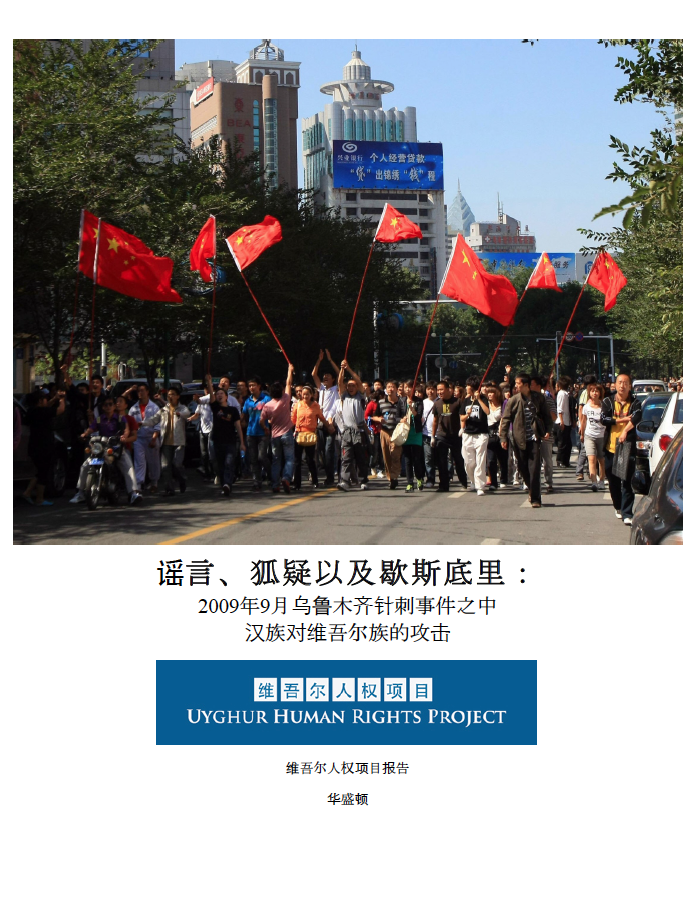
For immediate release
February 24, 2014, 11:00 am EST
Contact: Uyghur American Association +1 (202) 478 1920
The Uyghur Human Rights Project (UHRP) issues a Chinese-language version of its report Rumors, Suspicion and Hysteria: Urumchi’s Han Residents Target Uyghurs in September 2009 Pinprick Attack Scare. The report details the events of late August and early September 2009 in which a series of alleged pinprick attacks shook the regional capital of East Turkestan, Urumchi. The original report in English is available here.
The little documented incident gave rise to a series of human rights violations against the Uyghur people that demonstrate the vulnerability of Uyghurs in contemporary China. Allegations that Chinese officials did not investigate credible accounts of killings and beating of Uyghurs during September 2009 are of particular concern. The lack of due process in trials of Uyghurs alleged of conducting pinprick attacks also indicate an absence of international human rights standards for Uyghurs in China. It is UHRP’s fifth translation of a major report into Chinese.
“The translation of Rumors, Suspicion and Hysteria into Chinese marks UHRP’s commitment to producing reliable evidence in Mandarin of human rights abuses against the Uyghur people,” said UHRP director, Alim Seytoff in a statement from Washington, DC. “The series of incidents captured in this report are little known and should rightfully be highlighted for Chinese speakers. Not only do we see the Chinese government violating its own laws, but we also witness the discriminatory environment Uyghurs have to endure in their own homeland. The entire incident is a damning indictment on the Chinese government’s ethnic policies.”
The alleged attacks took place in the context of an unprecedented 10-month communications blackout in East Turkestan. Since the July 2009 unrest, the Internet, international dialing and personal texting had been cut in the region. Chinese authorities maintained near absolute control over the content of information and its transmission.
When rumors began to spread that perpetrators of pinprick attacks in Urumchi were transmitting infectious and fatal diseases through syringes, hysteria among residents in the city reached dangerous levels. As the agency in control of the flow of information and the welfare of all citizens in East Turkestan, the Chinese government mismanaged growing hysteria, which led to, UHRP has learned, indiscriminate killing and beating of Uyghurs.
UHRP is unaware of any investigation into violence carried out by Han Chinese or criminal charges stemming from these credible allegations. In its research, UHRP found that no alleged victim was infected with any disease and many of the cases reported in the official media did not result in a credible claim of a criminal act.
The detentions, trials and sentences which followed the alleged attacks were further evidence that regional officials were singling out Uyghurs in East Turkestan in order to regain control of restless Han Chinese residents in Urumchi. All the publicly known sentences handed down for pinprick attack convictions were given to Uyghurs. Most concerning is that the lengthy sentences, the longest being 15 years in prison, were handed down only two weeks after the alleged incidents had taken place. Given the swiftness of the criminal-judicial process and the calls from Han Chinese residents to government officials that action be taken against perpetrators of attacks, UHRP believes these convictions were tainted by political considerations and fell below the even usual very low standards of due process afforded Uyghurs.
UHRP has documented the events of August and September 2009 using interviews with eyewitnesses that were conducted in 2010 and secondary sources, including Chinese and overseas media. In addition, UHRP gained access to an archive of reports from the Urumchi Evening News in Uyghur that demonstrate the kind of information residents in Urumchi received from the government during the communications blackout. The archive, translated into English, forms an important element in the documentation of the alleged pinprick attacks.
The new Chinese version of report, Rumors, Suspicion and Hysteria: Urumchi's Han Residents Target Uyghurs in September 2009 Pinprick Attack Scare, can be downloaded at: http://chinese.uhrp.org/article/1844636208
